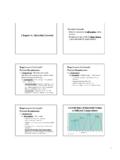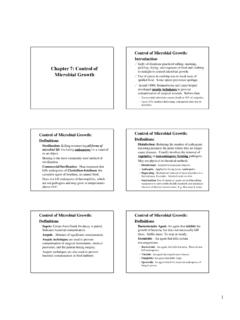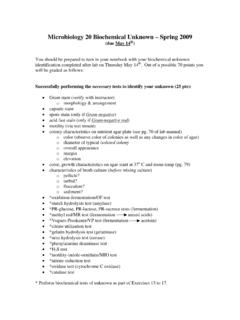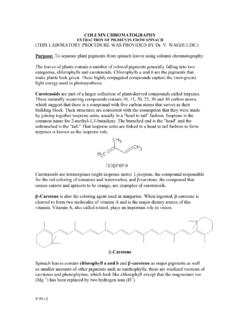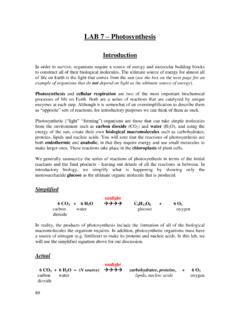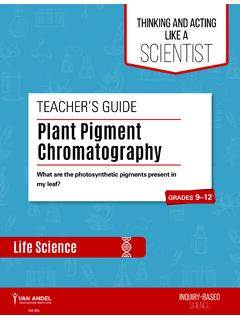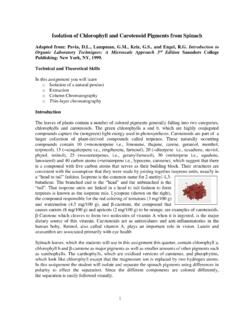Transcription of LAB #6 Photosynthesis and Cellular Respiration
1 1 LAB #6 Photosynthesis and Cellular Respiration Introduction In order to survive, organisms require a source of energy and molecular building blocks to construct all of their biological molecules. The ultimate source of energy for almost all of life on Earth is the light that comes from the sun (see the box on the next page for an example of organisms that do not depend on light as the ultimate source of energy). Photosynthesis and Cellular Respiration are two of the most important biochemical processes of life on Earth. Both are a series of reactions that are catalyzed by unique enzymes at each step. Although it is somewhat of an oversimplification to describe them as opposite sets of reactions, for introductory purposes let us examine them as such.
2 Photosynthetic ( light forming ) organisms are those that can take simple molecules from the environment such as carbon dioxide (CO2) and water (H2O), and using the energy of the sun, create their own biological macromolecules such as carbohydrates, proteins, lipids and nucleic acids. You will note that the reactions of Photosynthesis are both endothermic and anabolic, in that they require energy and use small molecules to make larger ones. These reactions take place in the chloroplasts of plant cells. We generally summarize the series of reactions of Photosynthesis in terms of the initial reactants and the final products - leaving out details of all the reactions in between. In introductory biology, we simplify what is happening by showing only the monosaccharide glucose as the ultimate organic molecule that is produced.
3 Simplified sunlight 6 CO2 + 6 H2O C6H12O6 + 6 O2 carbon water glucose oxygen dioxide In reality, the products of Photosynthesis include the formation of all of the biological macromolecules the organism requires. In addition, photosynthetic organisms must have a source of nitrogen ( fertilizer) to make its proteins and nucleic acids. In this lab, we will use the simplified equation above for our discussion. Actual sunlight 6 CO2 + 6 H2O + (N source) carbohydrates, proteins, + 6 O2 carbon water lipids, nucleic acids oxygen dioxide 2 You will note that one of the products of Photosynthesis is oxygen.
4 Essentially most of the oxygen in our atmosphere comes from the process of Photosynthesis . Like Photosynthesis , Cellular Respiration is also a series of chemical reactions. However, rather than requiring energy, this process involves the breakdown of molecules ( , glucose) releasing energy that can be used for any energy-requiring process in a cell. Thus, we call these reactions catabolic and exothermic. These reactions occur in the cytoplasm of bacteria and the mitochondria of eukaryotic cells (including plants !). Ultimately, the energy released from these reactions is used to form molecules of ATP, which can be described as the energy currency in the cell. Just as our country uses dollars as a means to transfer wealth, cells use molecules of ATP as a means to transfer energy from the reactions of Cellular Respiration to other reactions in the cell that require energy.
5 In essence, cells convert the energy derived from a molecule like glucose ( , a savings bond) into more useable molecules with energy called ATP ( , dollar bills that can actually be spent). In addition, since larger molecules such as glucose are broken down into the smaller molecules carbon dioxide (CO2) and water (H2O), this is catabolic process. Once again, for introductory purposes, we summarize the many chemical reactions of Cellular Respiration in one simple, overall equation: C6H12O6 + 6 O2 6 CO2 + 6 H2O glucose oxygen carbon dioxide water energy ADP + Pi ATP Although many cells prefer to use glucose as the primary molecule for Cellular Respiration , they can also use other carbohydrates, fats and proteins as a source of energy production when needed.
6 Note again that one of the products of Cellular Respiration is carbon dioxide. Deep sea organisms thrive in the absence of any light source In 1984, scientists made one of the most amazing discoveries in the history of science organisms that have evolved next to deep ocean volcanic vents that use chemical energy rather than sunlight as the basis of life. These organisms are known as chemoautotrophs ( chemical self feeding ). This discovery led to the hypothesis that such forms of life may be present on other planetary bodies in our solar system or other parts of the universe! 3 Part 1: Observing and Measuring Photosynthesis We have learned that Photosynthesis involves the conversion of carbon dioxide and water into organic molecules such as glucose.
7 In doing so, oxygen is a product while carbon dioxide is a reactant that is used up during Photosynthesis . In this experiment, we will be using the same plant you examined in Lab 3 called Elodea. The experimental set-up involves a qualitative measurement of the CO2 concentration in the vials. The variables to be examined in relation to carbon dioxide use are the amount of light exposure and various colors of light. The pH indicator bromothymol blue is used to estimate the amount of CO2 present in the vials. When CO2 concentrations increase in aqueous solution, it causes an increase in the concentration of H+ ions, thus decreasing the pH value. This occurs through the formation of an intermediary compound called carbonic acid, which forms by the combination of CO2 and H2O as shown here: CO2 + H2O < ===== > H2CO3 < ====== > H+ + HCO3- carbonic acid bicarbonate Bromothymol blue is yellow under acidic conditions, that is when the pH of the solution is less than 7 ( pH = 6).
8 This occurs when the concentration of CO2 is high. When there is little or no CO2 in the solution, the pH will be ~ and the bromothymol blue will actually be blue. Picture the relationship of pH to CO2 concentration being on a meter stick. The higher the concentration of CO2 - the lower the pH. The lower the concentration of CO2 - the higher the pH. Lower pH Higher pH Higher CO2 Level Lower CO2 Level YELLOW BLUE Exercise 1 Observing and Measuring Photosynthesis as CO2 is Consumed 1. Label 5 vials #1, 2, 3, 4 and 5 with a marker and line them up in order in a test tube rack. 2. Obtain 4 pieces of Elodea about 6 cm in length. 3. Obtain 2 pieces of aluminum foil and one colored plastic light filter.
9 4. In order to create a solution that is rich in CO2 for Photosynthesis , fill a 250 ml Erlenmeyer flask to the 150 ml line with tap water. 4 5. Put 5 ml of bromothymol blue solution into the flask. 6. Take a clean straw and blow bubbles carefully into the solution until it turns a distinct yellow. Note: the yellow color demonstrates an increasing level of CO2. 7. Place a 6 cm Elodea stem with leaves in vials #1, 2, 4 and 5. Vial #4 will not have any Elodea. 8. Fill vials #1, 2, 3 and 5 with this CO2 enriched solution containing bromothymol blue. 9. Fill vial # 4 with tap water and add one dropper full of bromothymol blue. 10. Wrap a piece of aluminum foil around vials #2 and #4. 11. Select one piece of colored plastic filter and wrap it around vial #5 and secure with a rubber band.
10 12. Tightly screw the caps on each vial. Turn the vials upside down in the rack so the Elodea has more light exposure. This chart summarizes the contents of each vial: Vial 1 Vial 2 Vial 3 Vial 4 Vial 5 CO2 Enriched Solution with X X X X H2O with X Elodea stem with leaves X X X X Aluminum Foil (to block light) X X Light Filter (red, green or blue) X = bromothymol blue 13. Expose vials #1, 3 and 5 to the light provided. Note: vials #2 and #4 are covered with foil and therefore will not receive any light. Record the starting color and time in the chart on your worksheet. Allow the experiment to run for two hours. After that time, record the colors of the five vials on the data chart on your worksheet.
